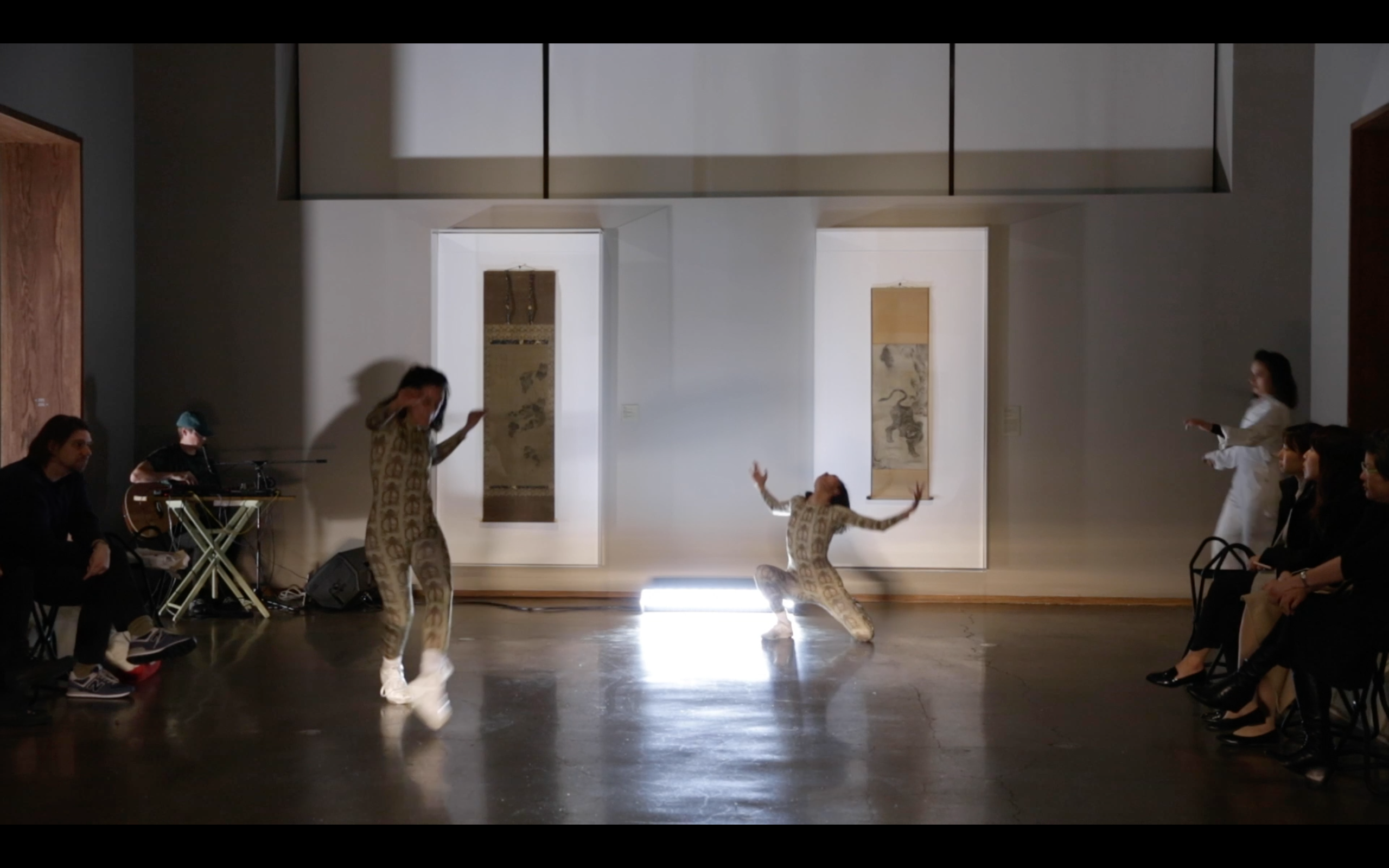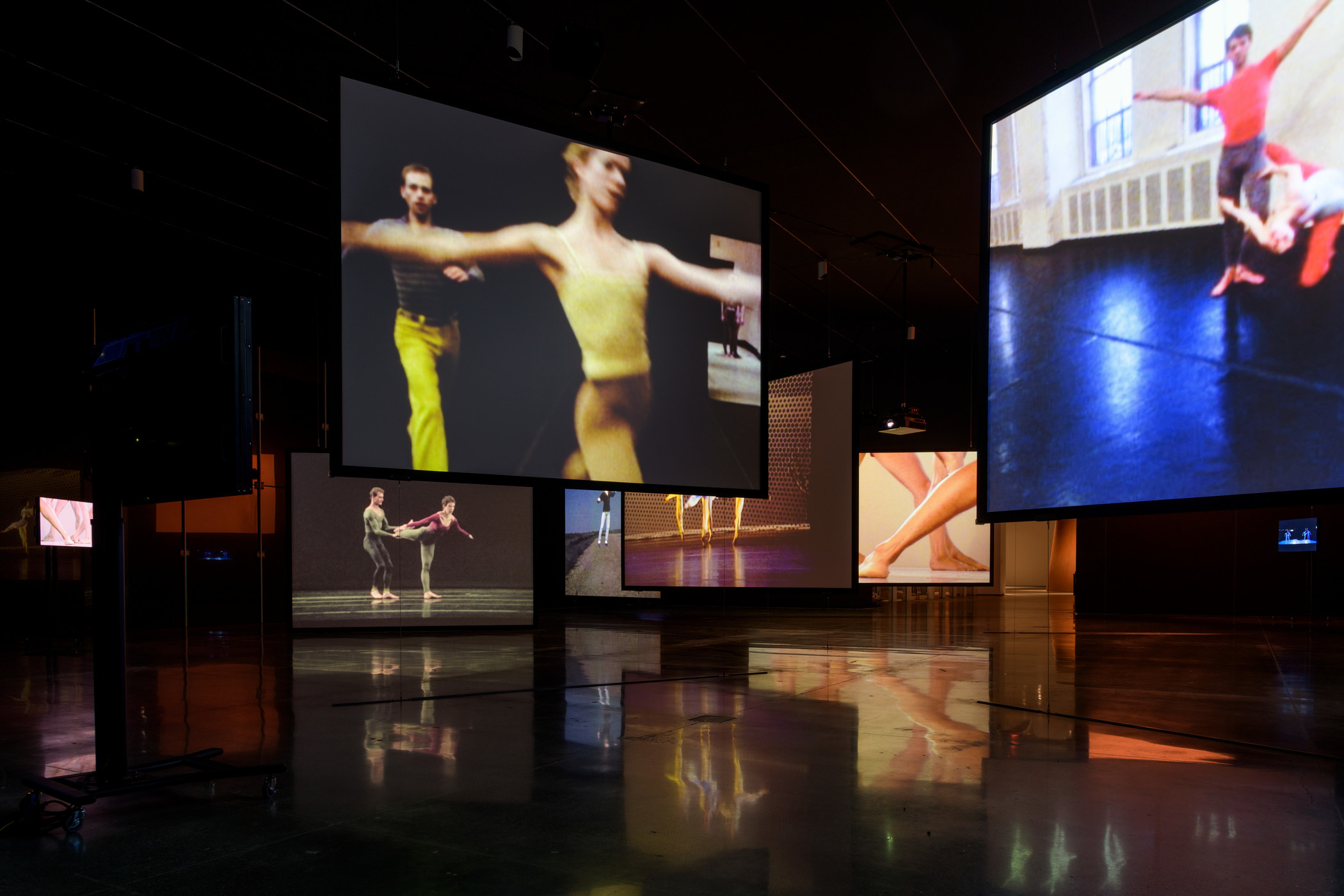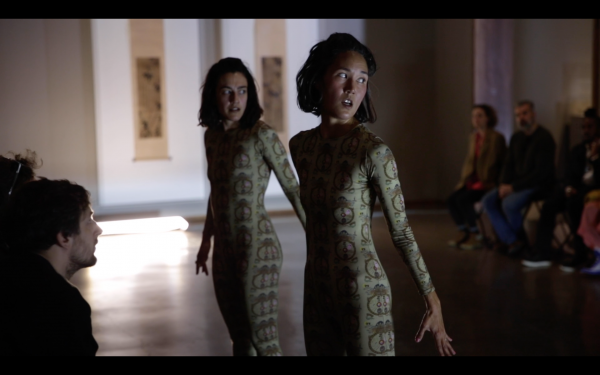LACMA’s exhibition Merce Cunningham, Clouds and Screens celebrates the prolific 60-year career of choreographer Merce Cunningham (1919–2009) who revolutionized dance by challenging every aspect of the form. Perhaps most radical was his idea that all the elements of a dance—movement, music, costumes, and decor—could be created independently of one another, coming together only during the “common time” of a performance. Along with his life partner, composer John Cage (1912–1992), Cunningham explored this freeing notion by initiating cross-disciplinary collaborations with dozens of artists.
The exhibition, on view through March 31, 2019, presents immersive installations by Charles Atlas and Andy Warhol, along with two video projections of early dances by Cunningham: Changeling and Night Wandering. Los Angeles-based choreographer and performer Jennie MaryTai Liu presented a commissioned project, Living Female Respondent or 53 Yakshi, responding to this exhibition in February 2019. She recently shared her reflections on the project and exhibition with us.
In 1960s diaries and letters, Merce Cunningham records days spent cooking beans and watching television, flipping between old movies, the news, and variety shows. In different spaces in which he lived and worked throughout the decades, I imagine him solo, or alongside his partner John, using chance to determine structure of movement in time and space—throwing hexagrams, flipping coins, tossing dice, opening his work up to other flows.
TV waves discharging into the ether, refracted in choreographic form. Western movement, for the first time, unhinged from the frontal perspective of the proscenium, holding multiple centers, requiring many attentions—discontinuous, infinite, prismatic like nature and television.
When you open your process up to the unknown, what other logics are let in? Does chance have interiority? Authorial voice, perspective, desire?
Though many who worked with Merce insist chance was only one strategy by which he made dances, decisions made by generating randomness built the scaffolding of many of his dances. “I make movements,” he said. Movement from his own kinesphere, sourcing nothing else. Then chance threw up proposals for what bodies can barely do, what minds would never think to do, and the dancing was the practice of puzzling, the labor of how to get from this strange point in space to the next. “I am no more philosophical than my legs,” he said.
In this moment in which I am a respondent to the time and practice of Merce, Souen-New York’s first macrobiotic restaurant can no longer keep its doors open and streams, clouds, and screens proliferate in images; my body is never pure source.

I set to task exhaustively appropriating Merce’s most rigorous employment of the I Ching, Book of Changes to make my own dance. I approached the internet at random until I had collected sixty-four videos, one to sixty-four seconds long, to replace Merce’s sixty-four movement phrases—the vocabulary bank, what Merce called ”the gamut,” to match sixty-four hexagrams in the Book of Changes. I invited a dancer named devika wickremesinghe, and together we encountered the random video content—humans doing things, humans not doing much, animals with graphics on them, racing cars, rotating cars, weather blissful and bad, bedroom broadcasts, lo-fi advertisements. We methodically downloaded all kinetics, lines, shapes, sounds, and voices through our dancing bodies and the dance-making devices we inherit. And then throwing hexagrams, again and again, skimming the surface of the three or four thousand-year-old intelligence of the I Ching, as Cunningham did, for numbers to apply to sequencing, spacing, and timing.
In the translation of the I Ching, Book of Changes, with the preface by Jung, the I Ching is offered as a tool for intervention in the visible world, to “free us from the tyranny of events.” By way of Merce, we are guided in a dandelion blow of the algorithms that trick and trap us. It all yields in lists, would-be feats to memorize and embody. We are completely disorganized. And in the labor of reorganizing, which is rehearsal, content becomes form. When we leave, our days are more silent.

I wander around the Atlas installation, a room of coincidences and synchronicities, seeing hundreds and thousands of hours of action that seems impossible—unlikely—being practiced, and bodies, vessels in unitards, now easeful, graceful, in a proposal of an unfixed field, in which there are no static states, only owned transitions.
What we all receive from Cunningham: it is not imperative that our movements accomplish anything. We don’t have to produce meaning, make new mythologies, carry old ones forward. It’s marvelous enough, never too simple, to be physical material, matter, kinetic energy engaged with all its attention in the figuring out of how to get from this position to the next. Merce, our totem ancestor, a changeling, a nightwalker, grants us this inheritance.
Yet, as female respondents, we are always subject to interpretation, bearers of signification, and we are partially constantly seeking it. We’re dancing seekers, and this is Los Angeles and we came here to be see-ers, so when we’re done with numbers we throw more hexagrams, and listen for meaning. Oracular voices indicate the essence of the situation prevailing, the situation being the dance, which is and isn’t inextricable from the dancer. Some whispers from nature: go a little too much in the direction of the small, get mean, cut through, rely on the capacity of self to bring about a fortunate change in circumstance.
Jennie MaryTai Liu is a Los Angeles-based artist and performer engaged with the body across mediums of choreography, writing, and video. She co-founded and edits riting.org, an experiment in writing which engages with performance being made here, now.



